The defeat of the Turkish army Osman Pasha and the fall of Pleven
prehistory
After forcing the Danube at Zimnitsa, the Russian Danube army advanced its Western detachment (Lieutenant General N. P. Credener’s 9 Corps) to capture Nikopol and Pleven. After a successful assault on Nikopol 4 (16) in July, the Russian command took no action for two days to capture Pleven located in 40 km, although there were no serious enemy forces there. The Russians could in fact simply enter the strategic fortress of the enemy. While the Russian troops were inactive, Osman-Pasha's army advanced from Vidin. She forced march, passing 200 km for 6 day, at dawn 7 (19) came out to Pleven and took up defensive positions on the outskirts of the city. The Ottomans immediately began to strengthen the defense of the fortress, turning it into a fortified area.
In the morning of July 8 (20), a Russian detachment under the command of Lieutenant-General Yu. I. Schilder-Schuldner attacked the fortress. But the Turks repelled the attack. 18 (30) July was the second assault on Plevna, which also failed and cost the Russian troops about 7 thousand people. In the meantime, the Ottomans in a short time restored the destroyed defenses, erected new ones and turned the nearest approaches to Pleven into a strongly fortified area with a number of troops defending it over 32 thousand people with 70 guns. The Osman Pasha grouping posed a threat to the Danube army from the flank. This failure forced the Russian command to suspend offensive operations on the main line of Constantinople.
The Western detachment had to be increased to a whole army, more than three times - 84 thousand people, 424 guns, including Romanian troops - 32 thousand people, 108 guns. It also housed the supreme leadership of Russia and Romania - Alexander II, Grand Duke Nikolai Nikolayevich and War Minister D. A. Milyutin, Romanian Prince Karl (he was formally the commander of the Western detachment). In the middle of the day 30 August (11 September) began the third assault on the Turkish stronghold. Skobelev squad in the 2-th half of the day was able to break through the enemy defenses and open the way to Pleven. But the highest Russian command refused to regroup its forces to the south and did not support Skobelev's detachment with reserves, which the next day, reflecting strong Turks' counterattacks, was forced to withdraw under the pressure of the superior forces of the enemy to their original position. Thus, the third offensive on Pleven, despite the high military prowess, dedication and resilience of Russian and Romanian soldiers and officers, ended in failure. Manifested errors in management. In particular, the intelligence of the Turkish troops and their defense system was weak, which caused the enemy to underestimate; the blows were made in the previous directions, where the enemy was already waiting for the attack and was well prepared; the interaction between the troops advancing on each of them was not organized; artillery preparation was ineffective; breakthrough squad Skobelev could not use, etc.
The unfortunate outcome of the offensive forced the higher Russian command to change the strategy. 1 (13) of September, Tsar Alexander II arrived at Pleven and convened a military council, at which he asked whether the army should remain at Plevna or whether to withdraw troops from the fortress. Lieutenant-General P. D. Zotov, Chief of Staff of the Western Detachment, and Lieutenant-General Prince N. F. Masalsky, Army Chief Artillery, spoke in favor of the retreat. For the continuation of the struggle for the fortress, Assistant Chief of Staff of the Danube Army, Major-General K. V. Levitsky, and War Minister D. A. Milyutin advocated. Milyutin proposed to abandon direct assaults and break the resistance of the enemy by siege. Milyutin noted that the troops, having no heavy artillery mounted fire, could not reliably destroy the defenses of the Ottoman army and succeed in open attack. In the case of a complete blockade, success is guaranteed, since the Turkish garrison does not have enough reserves for a long struggle. Indeed, the enemy was already out of stock. September 2 (14) Osman Pasha informed the High Command that the shells and food were running out, there were no reinforcements and the loss greatly weakened the garrison, which forces him to a dangerous retreat.
Alexander II supported Milutin. The council members decided not to retreat from Pleven, to consolidate their positions and wait for reinforcements from Russia, after which they planned to begin the proper siege of the fortress and force it to surrender. To guide the siege works assistant engineer commander of the detachment of the Romanian Prince Charles was appointed well-known engineer General E. I. Totleben, who became famous during the defense of Sevastopol. Arriving at the theater of war, Totleben came to the conclusion that the Pleven garrison was provided with food for only two months, and therefore could not withstand a prolonged blockade. General Zotov returned to his former duties as commander of the 4 corps. All cavalry was subordinated to I. V. Gurko. These changes have improved the management of troops. The Western detachment was again reinforced - the newly arrived Guards Corps (1-I, 2-I, 3-I Guards Infantry and 2-I Guards Cavalry Division, Guards Rifle Brigade) joined it.
Outing from Pleven. December 1877 d. Picture by unknown artist published in the English illustrated magazine The Illustrated London News in February 1878.
Siege
General Totleben skillfully led the siege works. To reduce losses in the army, he ordered the digging of solid trenches, building comfortable dugouts, bringing far-away hospitals to the front. Artillery had to make a careful adjustment, and then proceed to the methodical destruction of enemy fortifications.
Russian-Romanian troops surrounded Pleven from the north, east and south. In the west and southwest, the enemy had the opportunity to pass. Especially important for the Turkish garrison was the Sofia highway, on which the army of Osman Pasha received basic supplies. For the defense of this communication, the Turks strengthened the points of Gorniy Dubnyak, Dolny Dubnyak and Telish. In order to completely block the enemy garrison, it was necessary to cut his message with Sophia. At first, small Krylov and Loshkarev cavalry units were sent here. However, this was not enough. It was necessary to take enemy strong points on the highway. This task was to be solved by a newly formed detachment under the command of I. V. Gurko.
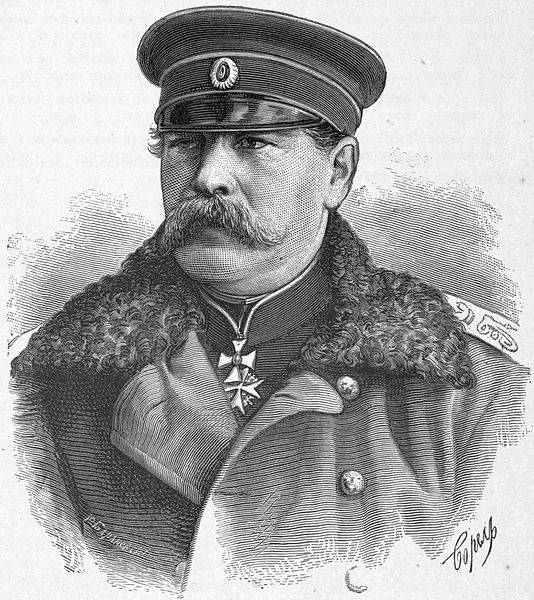
EI Totleben. Engraving from photo (1878)
Gurko squad was a very powerful force, the whole army - 50 thousand people with 170 guns. It was based on the guard, who had just arrived at Pleven. They decided to strike the first blow against Gorny Dubnyak, where 4,5, thousands of Turkish garrisons, sat with 4 guns. Turkish troops occupied good positions on the highlands, fortified with two redoubts and trenches. 20 battalions, 6 squadrons and 48 guns were assigned to attack enemy positions. The troops were supposed to simultaneously attack in three columns - from the north, east and south. In 8 hours 12 (24) in October, the Russians attacked the enemy. At the same time to attack the enemy did not work. The right column was the first to go forward, the other columns were moving late. Guardsmen, participating for the first time in the battle, bravely went on the offensive in close formation and suffered unreasonably heavy losses. The Turks were able to repel individual attacks of Russian columns. As Gurko noted: “... followed by a whole series of individual attacks. All the parts met with highly disastrous fire could not reach the main redoubt ”. By 12 hours, our troops took the Small Redoubt and surrounded the Big Redoubt, but due to the strong fire they could not break through and lay down.
Gurko decided to resume the offensive in the evening. At this time, our soldiers, using dashes and creeps, singly and in small groups accumulated around the redoubt. For the movement of soldiers used the folds of the area, ditches, ditches and pits. By 18 hours in the ditch has accumulated enough troops to attack. They were in the dead zone, could not get under the fire of the enemy. When dusk came our troops went to the assault on the redoubt. During the bayonet battle, the enemy was defeated and capitulated. However, the victory came at a high price. The loss of Russian troops amounted to 3,3 thousand killed and wounded. The Turks lost about 1,5 thousand killed and wounded and 2,3 thousand people captured.
The second blow was inflicted on Telish. 13 (25) October, our troops attacked the enemy strongpoint, but without success. Then Gurko decided to take the fortification of "artillery attack." The fortifications of the Turkish garrison and the surrounding area were studied. The artillerymen prepared firing positions, the corresponding engineering preparation of the offensive was carried out. Artillery preparation was thorough - 6 hours. A strict order of artillery preparation was established: from 12 to 14 hours - a powerful fire strike with all artillery; in 14 and 14 hours 30 minutes - three volleys with all artillery, and then methodical fire; in 16 hours 30 minutes - three volleys, then again methodical fire; in 18 hours - the last three volleys. Ammunition consumption was provided for 100 shells per gun. It was planned that if the enemy does not add up weapon after such a powerful fire strike, the troops will go on assault from three sides. Such thorough preparation led to success.
16 (28) October, the storming of Telish began. 4 brigades and 72 guns participated in the attack. The powerful and accurate fire of the Russian batteries demoralized the Ottoman troops. After the 3 hourly artillery preparation 5-thousand Turkish garrison capitulated. Russian losses did not exceed 50 people. October 20 (November 1) the enemy surrendered without a fight Mountain Dubnyak. On the same day, the advance units of the 3 Grenadier Division, which arrived in Bulgaria, approached the Mountain Metropolis, a village north-west of Pleven, interrupting communications with Vidin. Thus, the blockade of Pleven became complete.
The Turkish command decided to unblock the army of Osman Pasha. To do this, in the area of Orhaniye began to concentrate 25 thousand grouping. However, this enemy plan was destroyed by the actions of the Gurko squad. The general began a movement towards Orhaniye in order to crush the enemy corps and secure the way to Zabalkanie. The Turkish command, not daring to enter into an open battle with the Russians (the resistance of the Turkish troops in open battle was dubious), led the troops away from Orhaniye to the fortifications of Arab-Konak. Our troops, having reached this line, stopped. They completed their main task. The blockade of Pleven was secured and our troops took a comfortable position for the future movement for the Balkans.
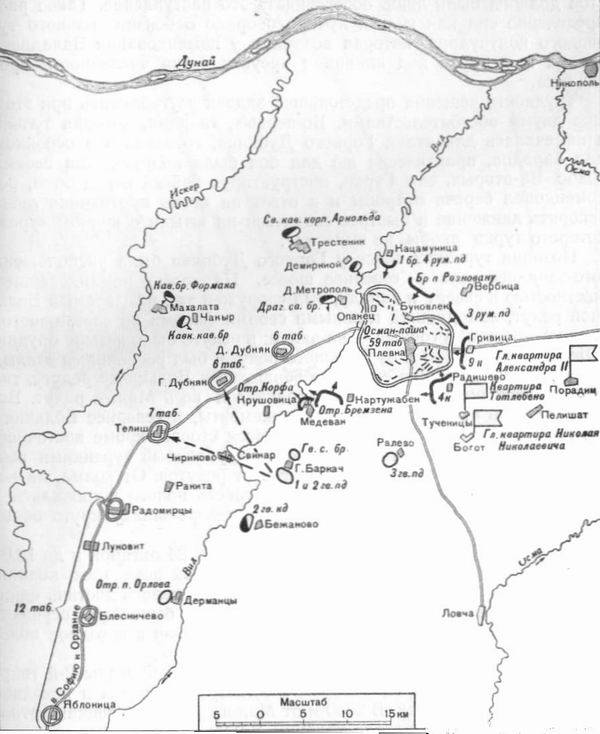
The location of the Western detachment to 24 October 1877 g. And the completion of the blockade of Pleven. Map source: N. I. Belyaev. Russian-Turkish war 1877-1878
Surrender
By the beginning of November, the number of Russian-Romanian troops near Plevna reached 130 thousand, 502 field and 58 siege weapons. The troops were divided into six sections: 1-th - Romanian General A. Chernat (consisted of Romanian troops), 2-th - Lieutenant-General N. P. Cridener, 3-th - Lieutenant-General P. D. Zotov, 4 th - Lieutenant-General M. D. Skobelev, 5-th - Lieutenant-General V. V. Kataley and 6-th - Lieutenant-General I. S. Ganetsky.
The position of the Turkish army was becoming increasingly difficult. Stocks of ammunition and food came to an end. From 13 (25) of October, Turkish soldiers were issued a rally on 0,5. Fuel is over. Thousands of soldiers were sick. October 22 (November 3) High Command in Constantinople allowed to leave Plevna, but it was too late. However, it was already impossible to remain in the fortress - the reserves ran out, and the demoralized soldiers were afraid of the Russian offensive, leaving their posts for the night, hiding in the city. Osman Pasha November 19 (December 1) convened a military council. Its members made the unanimous decision to break through from Pleven. The Turkish commander hoped to cross over to the left bank of the Vid River, strike Russian troops in the northwesterly direction on Magalette, and then move, depending on the situation, on Vidin or Sophia.
On the night of 27 on November 28 (December 9- 10), his troops launched from Pleven. For troops followed carts. Osman Pasha was also forced to take with him around 200 families from among the Turkish inhabitants of Pleven and most of the wounded. Division Tahira Pasha moved p. View and, having built up in deep columns in 7 hours, 30 minutes attacked the positions of the 3 grenadier division in the 6 sector. Despite all the precautions taken, the crossing of the Turkish army was for the Russian command a complete surprise. The 7 mouth of the 9 Siberian Grenadier Regiment could not withstand the attacks of the Turkish battalions 16. The Turks drove the Russian grenadiers out of the trenches, seizing 8 guns. 8 watches 30 minutes the first line of Russian fortifications between Dolnogo Metropol and Copana Grave was broken through. Under the pressure of desperately attacking, superior forces, the 9 th Siberian regiment withdrew to the second line of defense. He was assisted by the 10-th Little Russian Regiment, but he also could not stop the enemy and was overthrown. Ottoman troops around the 9 watch captured the second line of defense.
However, the Turks had already exhausted, they were caught in the crossfire and could not develop the offensive. At the beginning of the 11 hour, the 2-th brigade of the 3-th Grenadier Division (11-th Fanagory and 12-th Astrakhan regiments) approached from the Mountain Metropolis. As a result of the ensuing counterattack, the Russian grenadiers repulsed the second line of fortifications occupied by the enemy. The 3 Brigade was supported by the approached 7 Grenadier Samogit and 8 Grenadier Moscow regiments of the 2 Division. The arriving Russian reserves brought down on the enemy from three sides. The Turks retreated to the first line. Osman Pasha was waiting for the arrival of the second division from the right bank of the Vida, but its crossing was delayed by carts. Turkish troops lost even the appearance of mobility, taking with them wagons of civilians and wounded, having lost even a minimal chance of a breakthrough from the encirclement of the most combat-ready part of the army. The defeated Turkish troops, without receiving reinforcements, could not keep on the first line. By 12 hours of the day the enemy was knocked out of the first line of fortifications. As a result of the counterattack, the Russian troops not only beat off the 8 captured by the Turks, but also captured the enemy 10. Turkish troops lost about 6 thousand killed and wounded in this fight. Russian losses left around 1700 people.
Unsuccessful attempt to break through the army of Osman Pasha
General Ganetsky, still fearing a new attack by the Turks, did not plan to pursue the enemy. He ordered to take advanced fortifications, bring artillery here and wait for the new attack of the enemy. However, the situation was radically changed by the initiative of junior commanders. Having taken the fortified position of the Dolne-Dubnyaksky detachment, the 1 th brigade of the 2 th grenadier division, seeing the retreat of the Turks, went ahead and began to cover them from the left flank. Following it, the rest of the troops of the 6 area went on the offensive. Under the pressure of the Russians, the Turks at first slowly and in relative order retreated to Vida, but soon the retreating came upon their wagons. A panic began among the civilians following the wagon train, and she spread to the soldiers. Osman Pasha was wounded at that moment. Lieutenant Colonel Pertev Bey, the commander of one of the two regiments covering the wagons, tried to stop the Russians, but to no avail. His regiment was overturned, and the retreat of the Turkish army turned into an irregular flight. Bridges in dense mass crowded soldiers and refugees, guns, carts and pack animals. The grenadiers approached the enemy on 800 steps, firing rifle aimed fire at him.
It was a disaster. In the remaining sectors, the Russian troops also launched an offensive, and, seizing the fortifications of the northern, eastern and southern fronts, occupied Plevna and advanced to the heights to the west of it. The 1-I and 3-I brigades of the Turkish division of Adil Pasha, covering the retreat of the main forces of the Osman-Pasha army, laid down their arms. Wounded Osman Pasha, having lost hope of a successful breakthrough, in 13 hours of 28 in November (10 December) 1877 of the year sent the Russian command of his adjutant Neshed Bey with the announcement of surrender. 10 generals, 2128 officers, more than 41 thousand soldiers surrendered.
Dmitriev-Orenburg N. D. The last battle of the Plevna 28 in November 1877 of the year
Osman Pasha presents the saber to General I. V. Ganetsky
Results
The fall of Pleven was of strategic importance. Turkey lost an entire army, which shackled the further offensive of the Russian troops behind the Balkans. This made it possible for the Russian command to free up more than 100 thousand people for an offensive against the Balkans, which on the whole predetermined the defeat of Turkey in the war.
The Romanian army also liberated the main forces and was regrouped. A large group was thrown at Vidin and Belgradchik. 10 (22) December, the Romanian troops took Arnar-Palanca, located on the Danube. The main forces of the Romanian army in January 1878 of the year blocked Vidin. 12 (24) January Romanians took the external fortifications of the fortress. Vidin himself capitulated after the conclusion of a truce.
Park Skobeleva in Pleven
Monument to the heroes of Plevna at the Ilinsky Gate in Moscow
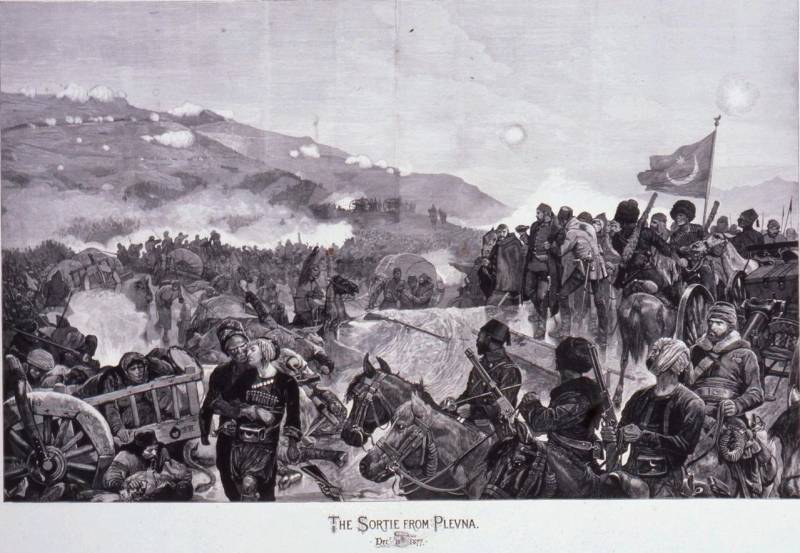
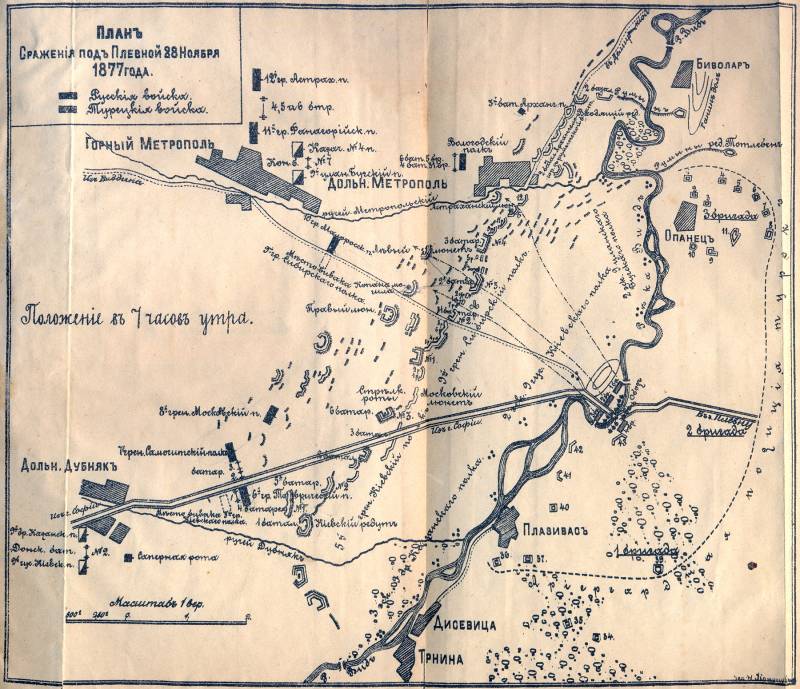
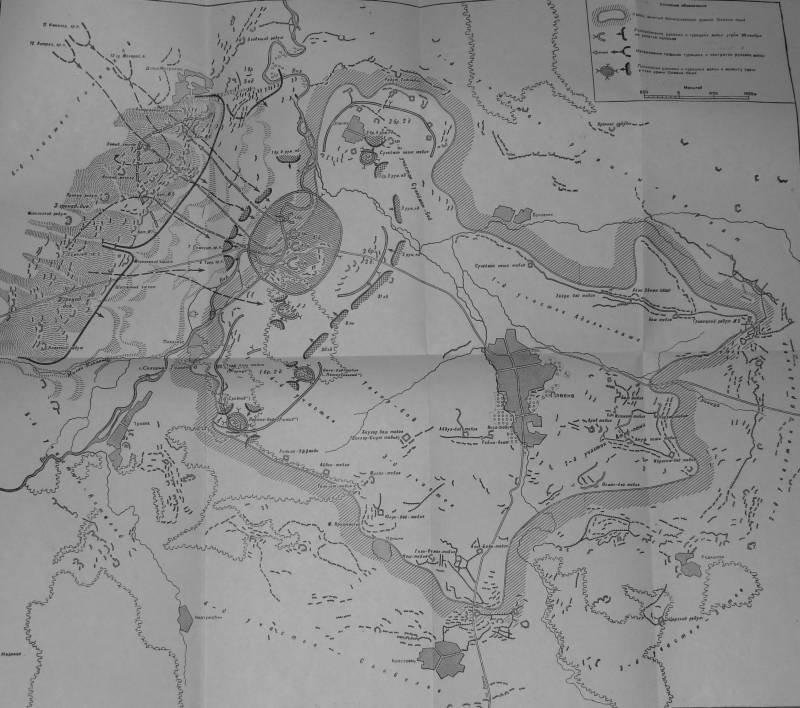
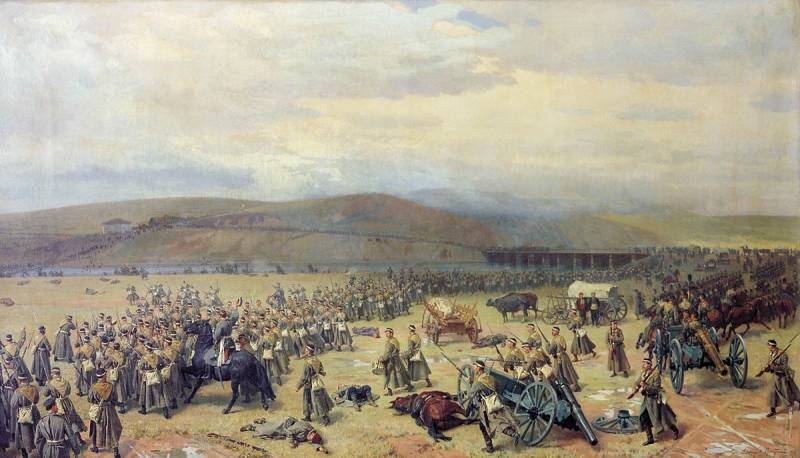
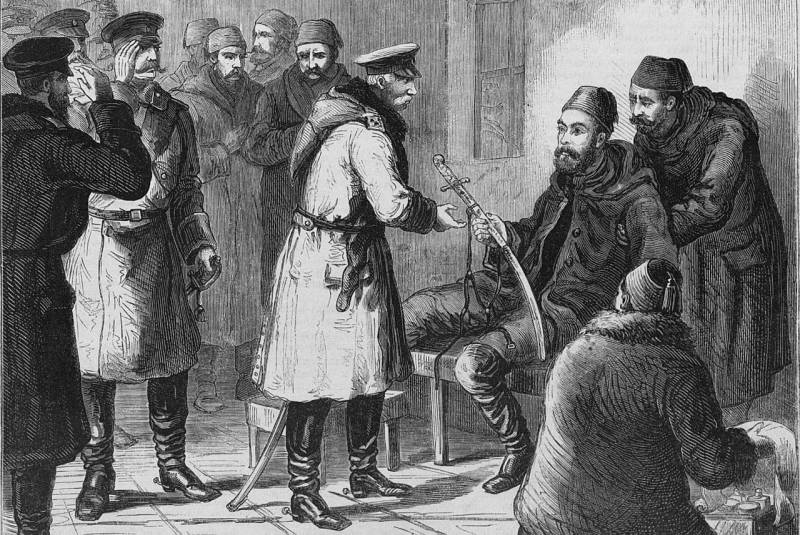
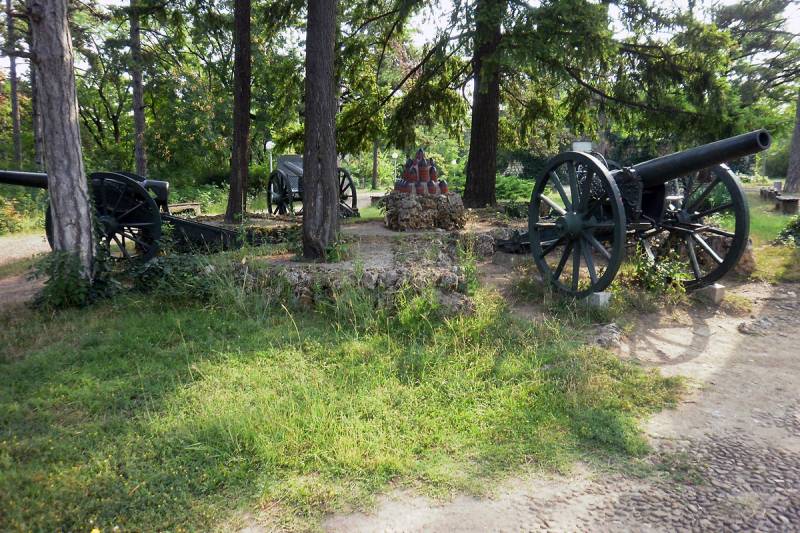
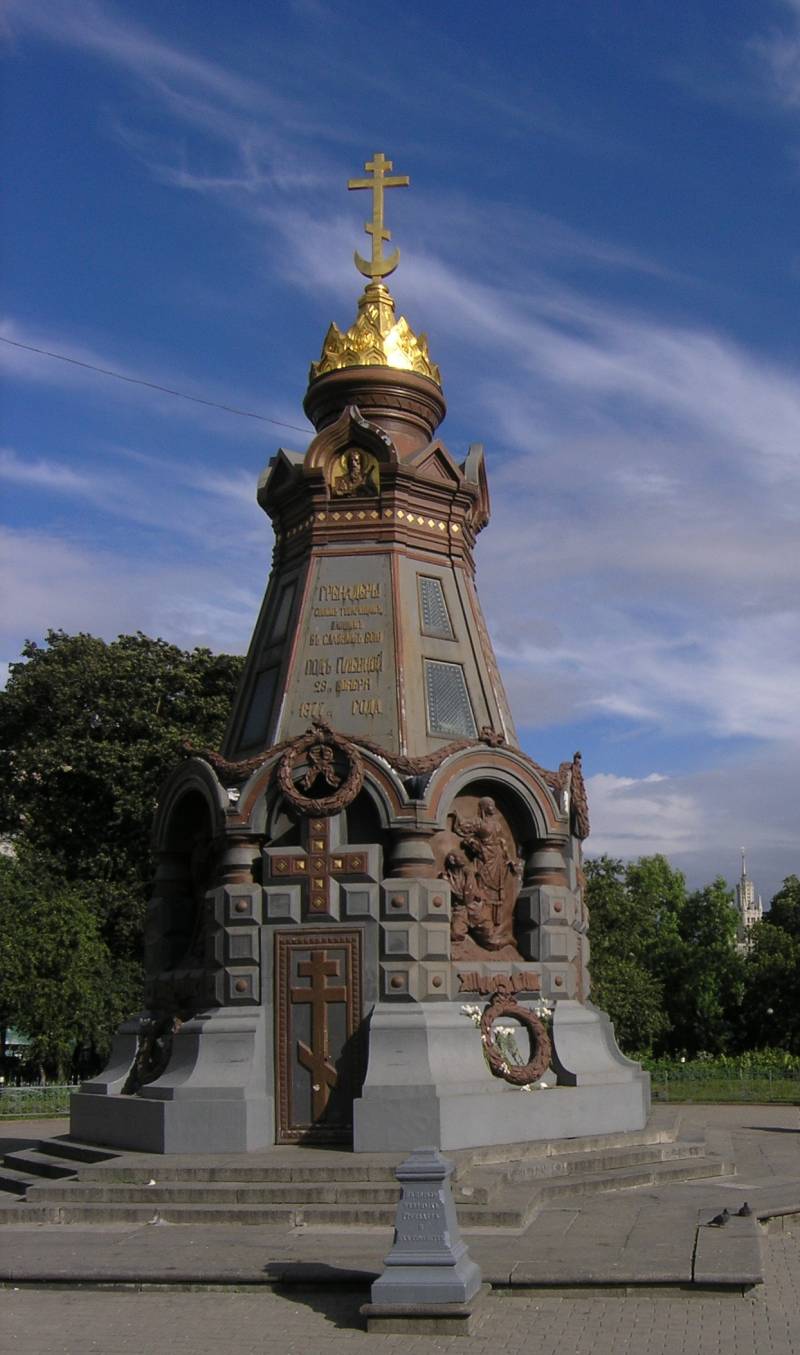
Information